Military ACAS Market Size
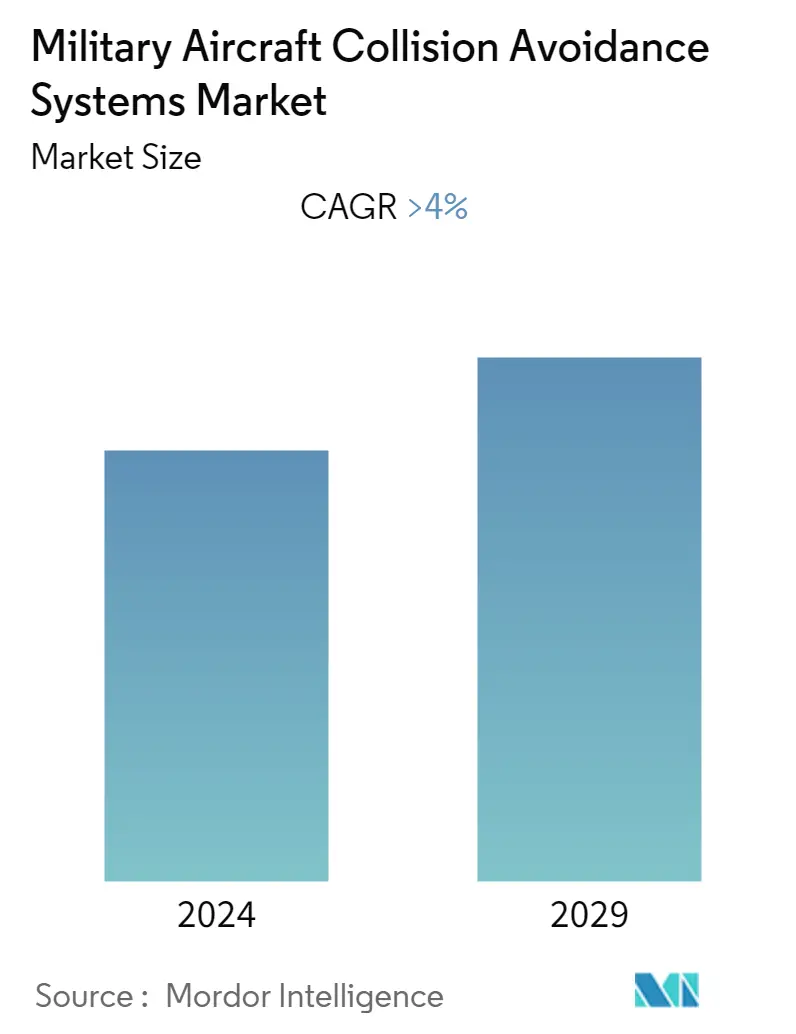
| Study Period | 2020 - 2029 |
| Base Year For Estimation | 2023 |
| CAGR | > 4.00 % |
| Fastest Growing Market | Asia-Pacific |
| Largest Market | North America |
| Market Concentration | High |
Major Players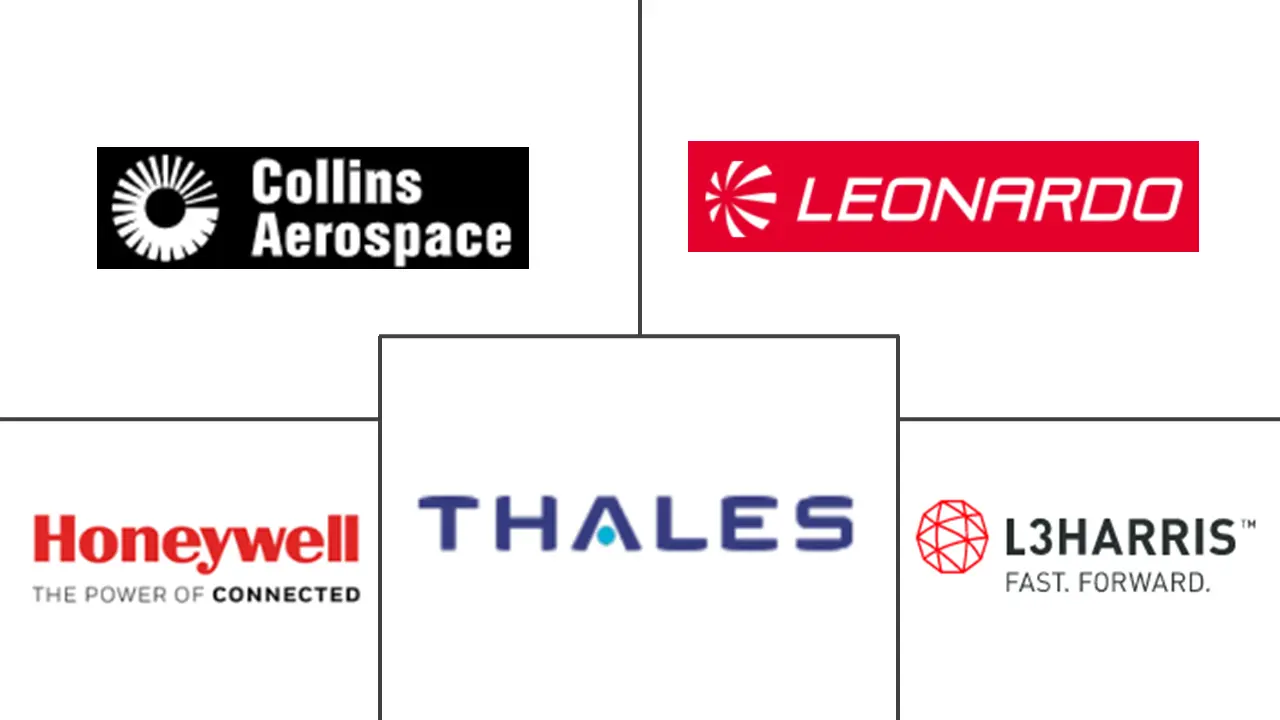
*Disclaimer: Major Players sorted in no particular order |
Need a report that reflects how COVID-19 has impacted this market and its growth?
Military ACAS Market Analysis
The military aircraft collision avoidance systems market is expected to grow at a CAGR of more than 4% during the forecast period.
The COVID-19 pandemic had a minor impact on the market. Although the production of military aircraft was slowed down for a brief period in 2020, the increase in military expenditure from all the countries has driven the demand for new military aircraft and has consequently driven the demand for military aircraft collision avoidance systems.
Increasing defense expenditure, rising military aircraft procurement contracts, and growing military modernization programs drive the growth of the market. An increasing focus on military aircraft safety is the major factor driving the market growth. Military aircraft operate in hazardous conditions, hence there are high chances of mid-air collisions and fatal accidents. Thus, military forces adopt sophisticated airborne collision avoidance systems, as the systems help to improve the operational safety of aircraft and pilots or troops.
Military forces across the world are using unmanned aerial vehicles (UAVs) for long-range missions. The collision avoidance systems in UAVs use onboard sensors to generate an image of the airspace surrounding the UAV. The sensor data is used to analyze various conflicts such as collisions, TCAS violations, and airspace violations. Since the implementation of collision avoidance systems is mandatory in UAVs, an increase in the adoption of UAVs may increase the demand for these systems, as they help to improve operational safety and enhance the lifetime of UAVs.
Military ACAS Market Trends
This section covers the major market trends shaping the Military ACAS Market according to our research experts:
The Unmanned Aircraft Segment is Anticipated to Growth with Highest CAGR During the Forecast Period
The unmanned aircraft segment is projected to register a high CAGR, owing to the growing UAV applications in the military and the rate at which the procurements of UAVs are growing among the militaries. The increasing usage of unmanned aircraft such as UAVs and other automated drones has been driving the demand for aircraft collision avoidance systems. Additionally, the rising defense expenditure and growing adoption of unmanned aerial vehicles for numerous applications from defense forces drive the growth of the market.
For instance, in January 2022, Sagetech Avionics, the United States-based aerospace technology company, teamed up with Northeast UAS Airspace Integration Research Alliance, Inc. (NUAIR) to work together to test Detect and Avoid (DAA) solutions, and Automatic Dependent Surveillance-Broadcast (ADS-B) transponders, which were developed by Sagetech Avionics. General Electric, together with its partners, is working on drone flights integrating the next-generation airborne collision avoidance system (ACAS X), which is being developed jointly with the Federal Aviation Administration (FAA). Furthermore, in July 2022, Iris Automation, a collision avoidance technology provider enter into a partnership with Sagetech Avionics that will offer uncrewed aircraft an air risk mitigation solution. Through the partnership, Sagetech Avionics' TSO-approved MXS ADS-B transponder will be integrated with Iris Automation's detect-and-avoid (DAA) system, Casia via Sagetech's ACAS X sensor fusion and collision avoidance module. This becomes a complete air risk mitigation solution for detection and avoidance. Several developments are expected to drive the unmanned aircraft segment of the market.
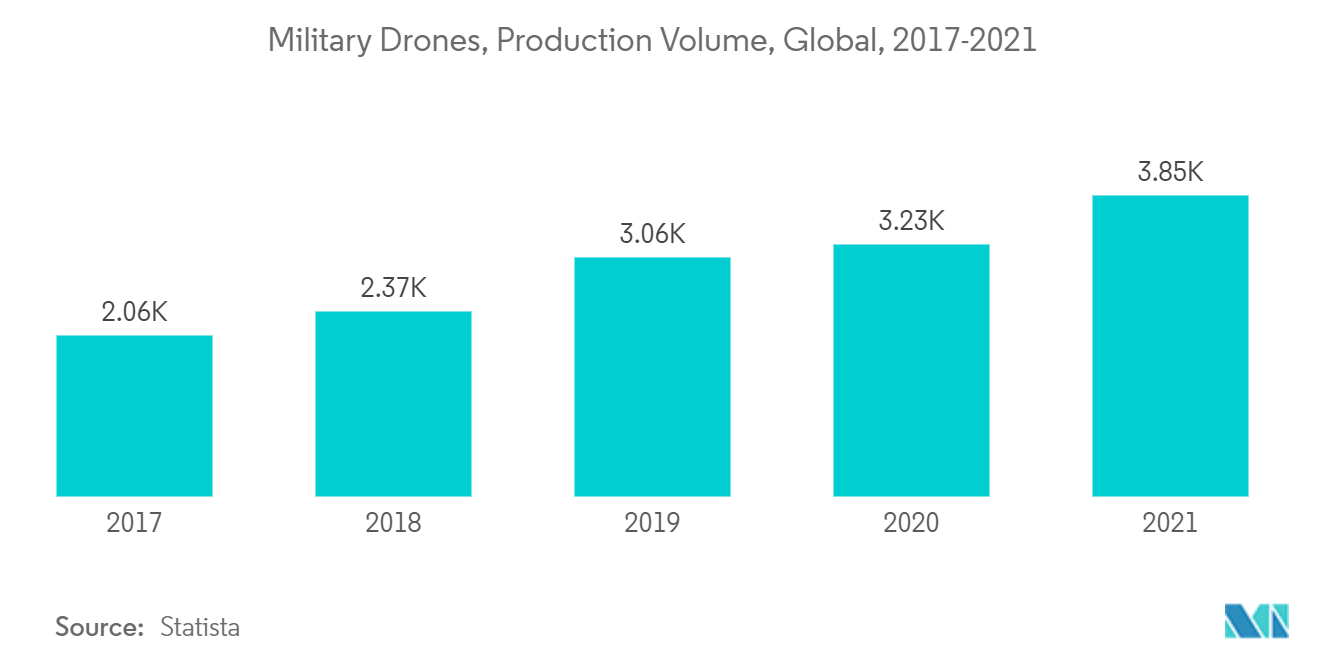
Asia Pacific is Projected to Show Remarkable Growth During the Forecast Period
The Asia Pacific region is expected to witness the highest growth rate during the forecast period, owing to the presence of countries like China and India that spend significantly on military aircraft procurement. Growing political disputes, cross-border conflicts between India and China, and rising terrorist activities lead to increasing defense expenditures from countries like China and India. For instance, in 2021, China allocated a defense budget of USD 293 billion while India spent a total of USD 76.6 billion on its defense sector.
Furthermore, these countries have been developing new technologies to prevent aircraft collisions. For instance, in October 2022, Paras Aerospace, a subsidiary of Paras Defense and Space Technologies Limited showcased an unmanned combat aerial vehicle (UCAV) at DefExpo 2022 that is designed and manufactured in India. It is equipped with collision avoidance radar, electronic support and countermeasure systems, air-to-air radar, and other systems. Furthermore, several new developments and innovations for safety systems have been driving the implementation of collision avoidance systems on board aircraft. In May 2022, China developed a ground collision avoidance and air collision avoidance system that enables unmanned military drones to help in surveillance and reconnaissance. This technology is expected to gradually be employed in the existing fleet of China for better military aviation safety. Such developments are expected to drive the demand for collision avoidance systems across the Asia Pacific region.
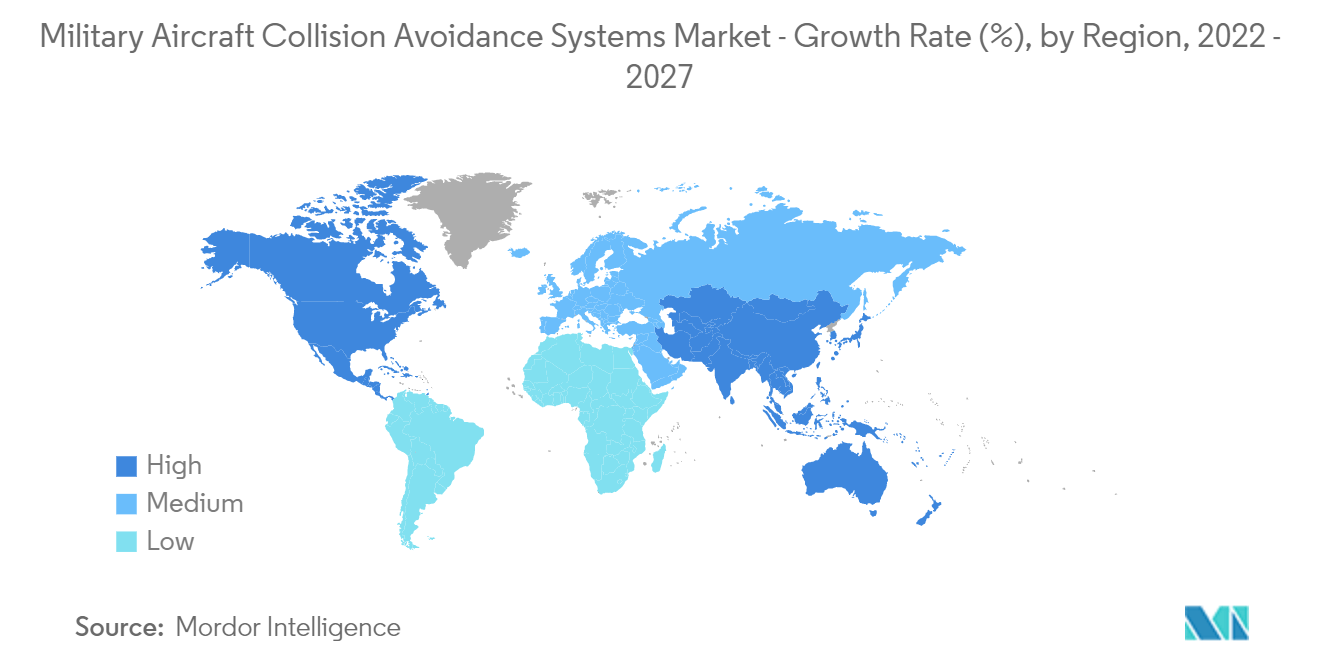
Military ACAS Industry Overview
The military aircraft collision avoidance systems market is consolidated, with few players holding significant shares in the market. Some of the key players are Honeywell International Inc., L3Harris Technologies, Inc., Raytheon Technologies Corporation, Leonardo SpA, and Thales Group. As flight safety is one of the areas where aircraft OEMs spend more on reliability, irrespective of the pricing, companies are trying to manufacture advanced collision avoidance systems with enhanced capabilities to ensure more safety for pilots and troops. Players are also working along with the aviation authorities and government bodies as well as the military end-users to develop next-generation collision avoidance systems. Increased focus on R&D and entry into strategic partnerships are expected to help the players in the long run.
Military ACAS Market Leaders
Honeywell International Inc.
L3Harris Technologies Inc
Leonardo SpA
Thales Group
Collins Aerospace (Raytheon Technologies Corporation)
*Disclaimer: Major Players sorted in no particular order
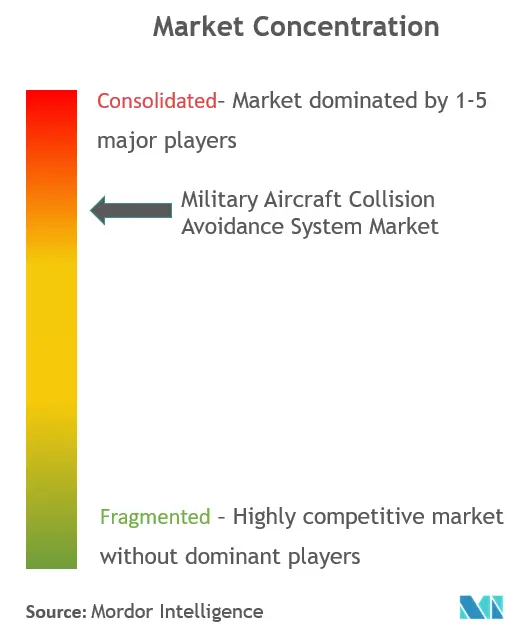
Military ACAS Market News
In November 2022, Honeywell International Inc. signed a memorandum of understanding (MOU) with PT Dirgantara Indonesia (PTDI), Indonesia's state-owned aircraft manufacturer for the supply of its Military Airborne Collision Avoidance System (MILACAS) for the Indonesian Air Force. MILACAS has a surveillance range of 100 nm for 360° azimuth. It uses improved interrogation methods and hybrid surveillance (ADS-B).
In April 2021, Lockheed Martin Corporation signed a modification contract worth USD 138 million for the development and fielding of capabilities for the automatic ground collision avoidance system and AGM-88 high-speed anti-radiation missile, an update to the data acquisition system, and improvements in radar software maturity.
Military ACAS Market Report - Table of Contents
1. INTRODUCTION
1.1 Study Assumptions
1.2 Scope of the Study
2. RESEARCH METHODOLOGY
3. EXECUTIVE SUMMARY
4. MARKET DYNAMICS
4.1 Market Overview
4.2 Market Drivers
4.3 Market Restraints
4.4 Porter's Five Forces Analysis
4.4.1 Threat of New Entrants
4.4.2 Bargaining Power of Buyers/Consumers
4.4.3 Bargaining Power of Suppliers
4.4.4 Threat of Substitute Products
4.4.5 Intensity of Competitive Rivalry
5. MARKET SEGMENTATION
5.1 System Type
5.1.1 Radars
5.1.2 TCAS
5.1.3 TAWS
5.1.4 CWS
5.1.5 OCAS
5.1.6 Synthetic Vision Systems
5.2 Aircraft Type
5.2.1 Manned Aircraft
5.2.2 Unmanned Aircraft
5.3 Geography
5.3.1 North America
5.3.1.1 United States
5.3.1.2 Canada
5.3.2 Europe
5.3.2.1 Germany
5.3.2.2 United Kingdom
5.3.2.3 France
5.3.2.4 Russia
5.3.2.5 Rest of Europe
5.3.3 Asia-Pacific
5.3.3.1 India
5.3.3.2 China
5.3.3.3 Japan
5.3.3.4 South Korea
5.3.3.5 Rest of Asia-Pacific
5.3.4 Latin America
5.3.4.1 Brazil
5.3.4.2 Rest of Latin America
5.3.5 Middle-East and Africa
5.3.5.1 United Arab Emirates
5.3.5.2 Saudi Arabia
5.3.5.3 Egypt
5.3.5.4 Rest of Middle-East and Africa
6. COMPETITIVE LANDSCAPE
6.1 Vendor Market Share
6.2 Company Profiles
6.2.1 Honeywell International Inc.
6.2.2 L3Harris Technologies, Inc
6.2.3 Collins Aerospace (Raytheon Technologies Corporation)
6.2.4 Leonardo SpA
6.2.5 Thales Group
6.2.6 Garmin Aerospace
6.2.7 Avidyne Corporation
6.2.8 Sandel Avionics Inc.
6.2.9 Northrop Grumman
6.2.10 Lockheed Martin Corporation
- *List Not Exhaustive
7. MARKET OPPORTUNITIES AND FUTURE TRENDS
Military ACAS Industry Segmentation
Aircraft collision avoidance systems are designed to reduce the incidence of a mid-air collision between multiple aircraft and also between the aircraft and the terrain. The unmanned combat aerial vehicle market is segmented based on the system type, aircraft type, and geography. By system type, the market is segmented into radars, TCAS, TAWS, CWS, OCAS, and synthetic vision systems. By aircraft type, the market is segmented into manned aircraft and unmanned aircraft. The market sizing and forecasts have been provided in value (USD billion).
| System Type | |
| Radars | |
| TCAS | |
| TAWS | |
| CWS | |
| OCAS | |
| Synthetic Vision Systems |
| Aircraft Type | |
| Manned Aircraft | |
| Unmanned Aircraft |
| Geography | |||||||
| |||||||
| |||||||
| |||||||
| |||||||
|
Military ACAS Market Research FAQs
What is the current Military Aircraft Collision Avoidance Systems Market size?
The Military Aircraft Collision Avoidance Systems Market is projected to register a CAGR of greater than 4% during the forecast period (2024-2029)
Who are the key players in Military Aircraft Collision Avoidance Systems Market?
Honeywell International Inc., L3Harris Technologies Inc, Leonardo SpA, Thales Group and Collins Aerospace (Raytheon Technologies Corporation) are the major companies operating in the Military Aircraft Collision Avoidance Systems Market.
Which is the fastest growing region in Military Aircraft Collision Avoidance Systems Market?
Asia-Pacific is estimated to grow at the highest CAGR over the forecast period (2024-2029).
Which region has the biggest share in Military Aircraft Collision Avoidance Systems Market?
In 2024, the North America accounts for the largest market share in Military Aircraft Collision Avoidance Systems Market.
What years does this Military Aircraft Collision Avoidance Systems Market cover?
The report covers the Military Aircraft Collision Avoidance Systems Market historical market size for years: 2020, 2021, 2022 and 2023. The report also forecasts the Military Aircraft Collision Avoidance Systems Market size for years: 2024, 2025, 2026, 2027, 2028 and 2029.
Military Aircraft Collision Avoidance Systems Industry Report
Statistics for the 2024 Military Aircraft Collision Avoidance Systems market share, size and revenue growth rate, created by Mordor Intelligence™ Industry Reports. Military Aircraft Collision Avoidance Systems analysis includes a market forecast outlook to 2029 and historical overview. Get a sample of this industry analysis as a free report PDF download.
